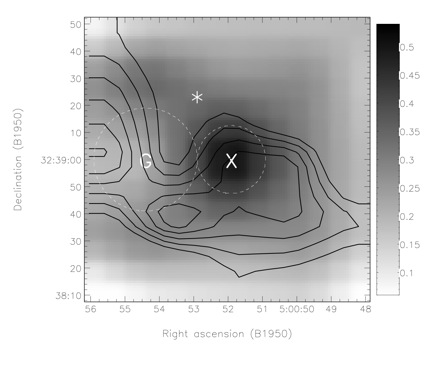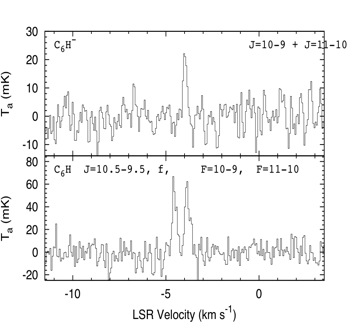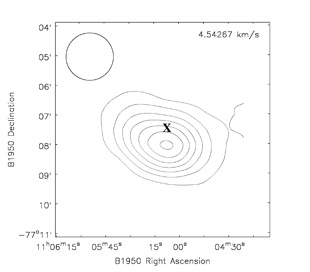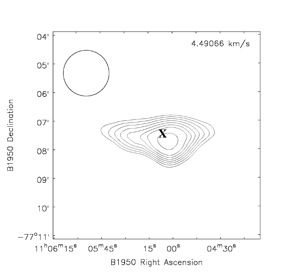2010 Annual Science Report
 NASA Goddard Space Flight Center
Reporting | SEP 2009 – AUG 2010
NASA Goddard Space Flight Center
Reporting | SEP 2009 – AUG 2010
Chemical Models of Nebular Processes
Project Summary
Theoretical and observational astrochemical studies have been undertaken. We participated in a combined experimental-theoretical project to elucidate the formation pathways to interstellar benzene. We have completed two observational projects related to interstellar organic chemistry. We have detected large carbon-chain anions in two new interstellar sources. A deep7mm line-survey of the very young protostar Cha-MMS1 has demonstrated that this object is very rich in organic molecules, indicative of inactive gas-grain chemistry.
Project Progress
We are undertaking theoretical and observational astrochemical studies of processes pertaining to the origin and evolution of organics in Planetary Systems. In the last year we have focused on the formation of aromatic and carbon chain molecules in low-temperature interstellar sources that can serve as analogs of processes which occurred either in the outer regions of nebula or in the presolar dense core.
Interstellar Benzene
In collaboration with members of the NAI Hawaii Team we have participated in a comprehensive study of interstellar benzene formation.
This involved laboratory studies of neutral-neutral reactions, quantum chemistry calculations, and astrochemical modeling. Our contribution was to use chemical models to examine the viability of the new 'neutral-neutral’ route to benzene (c-C6H6) through carbon insertion reactions involving CH with ethane (C2H6) which leads to propene (C3H6) then 1,3-butadiene (C4H6). The reaction of 1,3-butadiene with C2H produces benzene. These reactions have been studied in the laboratory and have been found to be rapid at low temperatures.
These and other related reactions have been incorporated into new chemical models. Where possible, we employed the most recent laboratory data and took care to correctly identify and treat the various hydrocarbon isomers such as allene (CH2CCH2) and propyne (CH3CCH), and to match or add where necessary the protonated and cationic forms with those species already in the UMIST database. A total of 167 new reactions were included in the network. New species in the model include 1,3-butadiene, propene, allene, 1,2,3-butatriene (C4H4), phenol (c-C6H5), phenyl acetylene (c-C6H5CCH) and benzo-nitrile ((c-C6H5CN.
Figure 1 shows the resulting organic chemical evolution in a dark cloud like TMC-1 in which grain ice mantles containing relatively simple organic molecules have been desorbed into the cold gas. We find in general that this route to benzene is more robust than previous models based on unmeasured and speculative ion-neutral pathways. A paper has been submitted to PNAS (Jones et al. 2010).
Search for Interstellar Organic Anions
Hydrocarbon anions have been shown to be an important part of the molecular inventory of the Galaxy by their recent discoveries in the quiescent molecular clouds TMC-1 and Lupus-1A, the carbon-rich AGB star IRC+10216, the protostar L1527, and the two pre-stellar cores L1544 and L1521F.
The presence of molecular anions in space is theorised to have a number of important implications for astrophysics. For example, they may play a critical role in the ionization balance of the ISM, acting as a source or sink of free electrons. Thus, their presence within magnetized, collapsing cores may have important consequences for star formation dynamics, through their influence on the ambipolar diffusion rate.
To further our understanding of the role of anions in astrophysics, searches for these elusive species by radio observations are necessary.
However, a recent survey for astrophysical anions resulted in their detection in only two new sources. Comparison with our unpublished maps of strong HC3N emission in several of these target sources, obtained at the Onsala Radio Observatory, we determined that the observed positions were probably not optimal for anion searches (see Figure 2).
Using our known HC3N emission peaks as guides, we obtained observing time at the NRAO Green Bank Telescope and detected microwave emission lines from the hydrocarbon anion C6H- and its parent neutral C6H in the pre-stellar core L1512 and the star-forming, dense interstellar cloud L1251A (see Figure 3). The measured anion-to-neutral ratios are 4.1% and 3.6%, respectively, which are within the range of values previously observed in the interstellar medium. This research contributes toward the growing body of evidence that large organic anions are relatively abundant in interstellar clouds, especially in regions surrounding pre-stellar cores and young, embedded protostars, and that cyanopolyyne chains can be successfully employed as signposts in searches for them. A paper has been submitted to ApJ Letters (Cordiner et al. 2010) and we have recently been awarded more GBT observing time to continue and extend the anion search program.
Organic Chemistry Around the Very Young Protostar Chameleon MMS1
One of the most important challenges in understanding the connection between astrochemistry and astrobiology is the origin and nature of the dense molecular cloud cores where protostars form. Recent observations suggest that the organic chemistry occurring in such regions is more complex than previously thought.
Cha-MMS1 has been classified as an early (low-luminosity) Class 0 protostar whose very young age is inferred from the lack of any detectable outflow. This gives it a unique place on the evolutionary sequence, in between a prestellar object and a young protostar. Thus, Cha-MMS1 represents an excellent target in which to examine in detail the chemical structure within and around a protostar that is just in the process of forming. We recently performed a deep 7~mm molecular line search in Cha~MMS-1 using the ATNF Mopra telescope. We detected many organic species, including the polyynes and cyanopolyynes (CnH and HCnN) which are typically found in only the most carbon-chain-rich molecular clouds. Methanol was also found to be highly abundant, which is evidence for the evaporation of grain-surface ices as the protostar warms up. We also obtained maps of HC3N and C4H (see Figure 4), which show emission peaks approximately spatially coincident with the location of the protostar and millimetre source. Our observations show that Cha-MMS1 contains a wide variety of organic molecular species with similar abundances to those found in the richest known astrophysical sources (including TMC-1). A paper is being prepared for publication based on these data (Cordiner & Charnley 2010, in preparation).and a proposal to probe the organic inventory using the Herschel Space Observatory has been submitted.

Figure 1. Figure 1. TMC-1 dense cloud model results at T=10 K showing abundances of benzene, allene, 1,2,3-butatriene, phenol, phenyl acetylene and benzo-nitrile as a function of time after injection of ice mantle species. (Jones et al. 2010).

Figure 2. Figure 2. Grayscale Onsala HC3N J=10-9 map of L1512 with C4H N=9-8 contours overlaid. The scale bar is in units of K km/s. C4H contours show peak antenna temperature, starting at 0.36~K, and increasing in steps of 0.02~K. The location of the previous anion search by Gupta et al. is labeled 'G’. The HC3N peak position we used is labeled 'X’, and the location of the sub-mm source is labelled with an asterisk. Dashed circles represent the FWHM telescope beam sizes of the respective observations. (Cordiner et al. 2010).

Figure 3 Top. Figure 3. The C6H- J=10-9 and J=11-10 spectra, and C6H J=10.5-9.5 spectra, observed towards L1251A (top) and L1512 (bottom) (Cordiner et al. 2010).

Figure 3 Bottom. Figure 3. The C6H- J=10-9 and J=11-10 spectra, and C6H J=10.5-9.5 spectra, observed towards L1251A (top) and L1512 (bottom) (Cordiner et al. 2010).

Figure 4 Top. Figure 4. Mopra maps of HC3N (top) and C4H (bottom) around Cha-MMS1. The arcsec beam size shown upper left. The location of peak 1.3~mm emission from the protostar is labeled 'X’ and lies slightly north of the peak of emission from the cold carbon chains (Cordiner & Charnley 2010, in preparation).

Figure 4 Bottom. Figure 4. Mopra maps of HC3N (top) and C4H (bottom) around Cha-MMS1. The arcsec beam size shown upper left. The location of peak 1.3~mm emission from the protostar is labeled `X’ and lies slightly north of the peak of emission from the cold carbon chains (Cordiner & Charnley 2010, in preparation).
-
PROJECT INVESTIGATORS:
-
RELATED OBJECTIVES:
